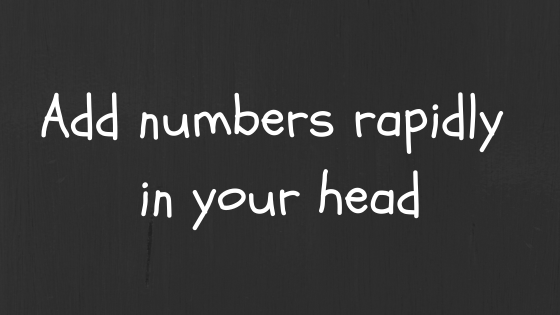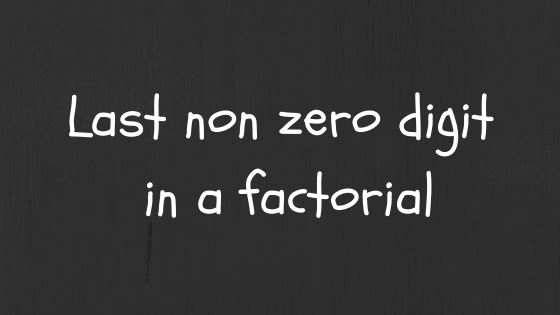
Addition Tricks: Add Numbers Rapidly In your Head
March 5, 2020
How to find Last Non Zero Digit in a Factorial
October 1, 2020In this post we will look into the different types of patterns followed by a number series. The patterns that we shared here are some of the common patterns to give you an idea on how to approach a number series problem. However, there is no hard and fast rule that a number series follows only the patterns mentioned in this. The post aims to help you define a structured approach to solving a number series problem.
What is a Number series?
Perfect Squares Series
A sequence in which each of the numbers is a perfect square is generally termed as Perfect square series. In other words, if the square roots of each of the numbers in the sequence is a natural number it is considered as a perfect square series.
[toggles type=”accordion”][toggle title=”36, ?, 64, 81, 100, 121. “]
Here we notice that the first number is a perfect square of 6, third number is square of 8, fourth number is square of 9 and so on. Based on this pattern, we can deduce that the missing number must be 49, which is square of 7.
[/toggle]
[toggle title=”121 , 169 , 225 , ?, 361″]
Here 121 is a perfect square of 11, 169 is the square of 13, 225 is square of 15 and 361 is square of 19.
The sequence is basically squares of alternate numbers starting with 11.
i.e. 11, 13, 15, ?, 19.
Hence the series is perfect square series with the missing number being the square of 17 = 289.
[/toggle]
[toggle title=”961 , 1024 , ?, 1156, 1225 “]
In this sequence, if we calculate the square roots of each of the numbers, we get:
31, 32, ?, 34, 35
Hence, the sequence is a square of consecutive numbers starting with the square of 31. Accordingly, the missing number in this sequence is the square of 33, which is 1089
[/toggle]
[/toggles]
Perfect Cube Series
A sequence in which each of the numbers is a perfect cube or if the cube roots of each of the numbers in the sequence is an integer, it is referred to as a perfect cube series.
[toggles type=”accordion”][toggle title=”1 , 27 , 125 , 343 , ?”]
Here we notice that the first number is a perfect cube of 1, second number is cube of 3, third number is cube of 5, fourth number is cube of 7. Hence the fifth number must be a cube of 9 which is 729.
[/toggle]
[toggle title=”1000, 8000, 9000, ?, 125000″]
Here 1000 is a perfect cube of 10, 8000 is the cube of 20, 9000 is cube of 30 and 125000 is cube of 50.
The sequence is basically cube of multiples of 10
i.e. 10, 20, 30, ?, 50
Hence the series is perfect cube series with the missing number being the cube of 40 = 64000.
[/toggle]
[toggle title=”4096, 4913, ?, 6859, 8000 “]
In this sequence, if we calculate the cube roots of each of the numbers, we get:
16, 17, ?, 18, 19
Hence, the sequence is a cube of consecutive numbers starting with the cube of 16. Accordingly, the missing number in this sequence is the cube of 18, which is 5832
[/toggle]
[/toggles]
Geometric Series
A sequence in which each of the numbers is obtained by multiplying or dividing the preceding number by a constant number is referred to as a Geometric series. That is the common ratio between the successive terms is always the same in this series.
[toggles type=”accordion”][toggle title=”3, 9, 27, 81 , ?”]
Here we notice that each of the numbers is obtained by multiplying its preceding number by 3. i.e the second number is obtained by multiplying the first number 3 by 3, the third number 27 is obtained by multiplying the second number 9 by 3. Hence the common ratio is 3.
Similarly the fifth number is obtained by multiplying the 81 by 3 which is 243.
[/toggle]
[toggle title=”6144, ?, 384, 96 , 24″]
This is a descending series where fifth number divided by fourth number gives 4 and the third number by fourth number gives 4.
Hence this is a geometric number series where each number in the series is obtained by dividing the preceding number by 4. Thus the second number is obtained by dividing 6144 by 4 = 1536
[/toggle]
[/toggles]
Arithmetic Number Series
A sequence in which each of the numbers is obtained by adding or subtracting the preceding number with a constant number is referred to as a Arithmetic series. In other words the common difference between any terms in the series is always the same in an arithmetic series.
[toggles type=”accordion”][toggle title=”3, 9, 15, 21, ?”]
This is an increasing sequence in which the subsequent term is obtained by adding the preceding term with 6. i.e the common difference between any two terms in the series is 6.
9 = 3+6, 15 = 9+6, 21 = 15+6
Hence the fifth term is obtained by adding 6 to 21 => 27
[/toggle]
[toggle title=”72, 63, 54, ?, 36″]
This is a descending series in which the subsequent term is obtained by subtracting 9 from the preceding term. Since the difference between two subsequent terms is constant this is an arithmetic number series.
Accordingly, the fourth term in the series 54 – 9 = 45
[/toggle]
[/toggles]
Two-stage Type Series
In this series, the difference of consecutive terms will be an Arithmetic series. i.e the common difference of the differences in this series is same.
Two-stage Type Series Examples
[toggles type=”accordion”][toggle title=”1, 3, 6, 10, 15, ?”]
Calculate the difference of consecutive terms:
3 – 1 = 2, 6 – 3 = 3, 10 – 6 = 4, 15 – 10 = 5
Notice that these difference 2, 3, 4, 5 form a arithmetic series with common difference 1. This type of series is known Two Stage Type Series.
Now, the in 2, 3, 4, 5 with common difference 1 will be 6.
Hence the missing number in 1, 3, 6, 10, 15 will be 15 + 6 = 21
[/toggle]
[toggle title=”45, 38, 33, 30, ?”]
Calculate the difference of consecutive terms:
45 – 38 = 7, 38 – 33 = 5, 33 – 30 = 3
Notice that these difference 7, 5, 3 form a arithmetic series with common difference 2.
Now, the fourth term based on this common difference will be 1 => 7, 5, 3, 1.
Hence the fifth term in the sequence is 30 – 1 = 29
[/toggle]
[/toggles]
Mixed Series
The numbers in this series is obtained by an identifiable arbitrary pattern. Lets understand this with the help of examples below:
Mixed Series Examples
[toggles type=”accordion”][toggle title=”7, 16, 34, 70, 142, ? “]
Notice here that
16 = 7×2 + 2
34 = 16×2 + 2
70 = 34×2 + 2
142 = 70×2 +2
As you have noticed, each number in this series is obtained by multiplying its preceding number by 2 and then adding 2 to it. This kind of series which follows an arbitrary pattern is normally referred to as Mixed series.
Hence the 6th term in this series will be 142×2 + 2 = 286
[/toggle]
[toggle title=”0, 6, 24, 60, 120, 210, ?”]
Here,
First Term -> 0 = 1$^3$-1
Second Term -> 6 = 2$^3$-2
Third Term -> 24 = 3$^3$-3
Fourth Term -> 60 = 4$^3$-4
Fifth Term -> 120 = 5$^3$-5
Sixth Term -> 210 = 6$^3$-6
Accordingly, the Seventh term will be 7$^3$-7 = 336
[/toggle]
[/toggles]
Twin – Alternate Series
A single sequence consisting of two series is termed as Twin series. In this type of series the series formed by alternating terms may be independent by itself.
Twin – Alternate Series Examples
[toggles type=”accordion”][toggle title=”3, 5, 9, 7, 15, 9, 21, ? “]
The types that you notice in this series are
Series 1: 3, 9, 15, 21…
Series 2: 5, 7, 9,
Missing term refers to the second series which has a common difference 2. Hence the missing term obtained by adding 2 to 9 => 11
[/toggle]
[toggle title=”0, 2, 3, 5, 8, 10, 15, ?, ?”]
Series 1 = 1$^2$-1 = 1, 2$^2$-1 = 3, 3$^2$-1 = 8, 4$^2$-1 = 15
Series 2 = 1$^2$+1 = 2, 2$^2$+1 = 5, 3$^2$+1 = 10
Accordingly,
8th term will be 4$^2$+1 = 17 &
8th term will be 5$^2$-1 = 24
[/toggle]
[/toggles]


1 Comment
Just what I needed. Hats off to the JustQuant.com team!